LagosPortugalGuide.com
The best independent guide to Lagos
LagosPortugalGuide.com
The best independent guide to Lagos
Day trip to Lagos and a 1-day self guided walking tour
Lagos offers a perfect balance of history, culture and natural beauty that sets it apart from other Algarve destinations. This coastal town boasts a fascinating maritime history as the launching point for Portugal's Age of Discoveries, while today it charms visitors with its walled old town, stunning cliff-backed beaches, and lively atmosphere.
Lagos is easily reached from most Algarve coastal towns and rewards visitors with a rich array of sights—from its historic churches and cultural museums to the dramatic coastal formations of Ponta da Piedade. Unlike many tourist destinations, Lagos maintains an authentic Portuguese character throughout its winding streets and squares.
This article will help you plan the perfect day trip to Lagos. It is divided into two parts: the first explains why you should visit Lagos along with practical details, while the second section provides a detailed self-guided walking tour.
Highlights of a day trip to Lagos
Ponta da Piedade - A spectacular headland to the south of Lagos, with golden cliffs, sea arches, and hidden grottoes that can be explored by boat or along clifftop walking paths.
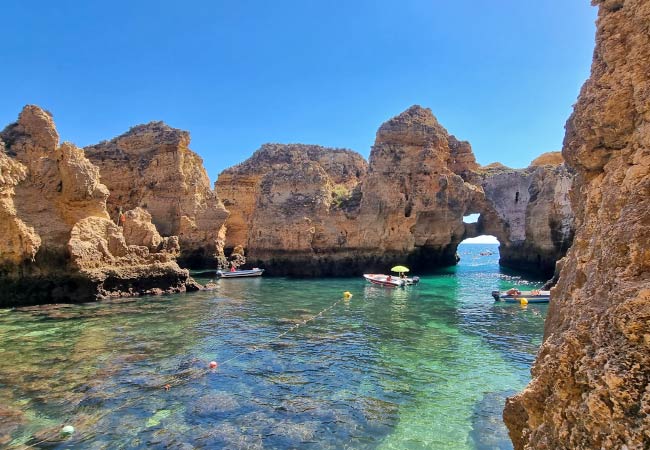
Historic Center - The charming old quarter of Lagos, with its cobbled streets, whitewashed buildings, traditional Portuguese architecture, and atmospheric squares.
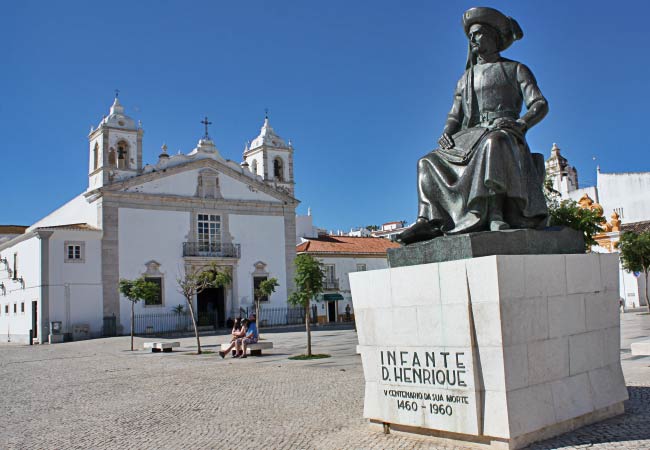
Praia Dona Ana - One of Portugal’s most beautiful beaches, where crystal-clear turquoise waters meet soft sands and are surrounded by towering golden cliffs.
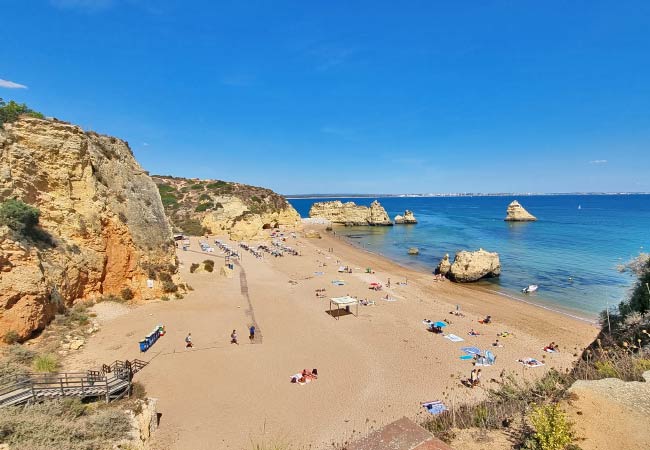
Forte da Ponta da Bandeira - This delightful 17th-century fort guarded Lagos's harbour entrance against pirate raids and stands as a compelling reminder of the city’s strategic importance during Portugal's seafaring era.
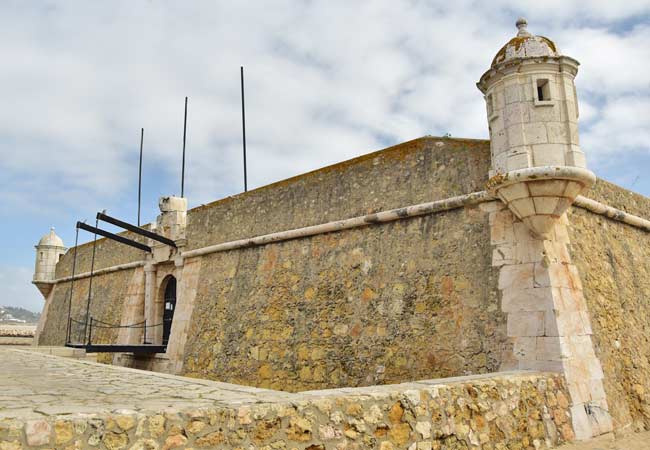
Why Have a Day Trip to Lagos?
Lagos offers the perfect blend of historical significance, authentic Portuguese character and natural beauty that's often missing from pure beach resorts. Unlike purpose-built tourist centres, Lagos developed organically over centuries as an important port town, giving it genuine character and cultural depth.
The town packs remarkable variety into a compact area that can be easily explored on foot. Within just a few hundred metres, you can walk from a 17th-century fort to golden beaches, historic churches, and lively squares lined with cafés and restaurants.
The stunning coastal scenery around Lagos is among the best in the Algarve. The golden cliffs, hidden coves, and sea caves of Ponta da Piedade offer views that rival any in Portugal. These natural formations can be appreciated from cliff-top walking paths or explored up close by small boat tours.
Lagos has preserved its heritage while thoughtfully embracing tourism. The result is a town that feels authentically Portuguese even during the busy summer months. Local restaurants serve traditional dishes, small shops sell regional products, and Portuguese life continues among the historic streets.
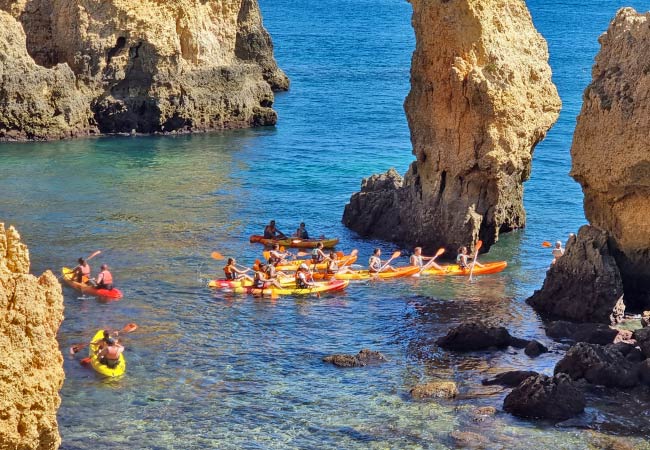
A kayak tour around the Ponta da Piedade
Lagos Compared to Other Algarve Day Trips
Lagos is just one of many popular destinations for a day trip in the western Algarve. Here we hope to show you why you should choose it over other destinations.
Lagos vs Portimão - While Portimão has a pretty riverside setting and excellent seafood restaurants, it lacks the historical charm and the magnificent coastal scenery of Lagos. Portimão functions primarily as a modern residential city with some shopping areas, whereas Lagos offers a much more interesting destination for a day trip.
Lagos vs Silves – Originally the Moorish capital of the Algarve, Silves boasts a massive castle and fortifications. However, Silves is considerably smaller than Lagos, while Silves can be thoroughly explored in about two hours, Lagos requires almost a full day to fully see. (Silves guide)
Lagos vs Faro - As the regional capital, Faro offers many varied sights including its walled old town and cathedral, plus excellent museums and shopping. Both Faro and Lagos are equally good places to visit as a day trip, with your choice often depending on which is closer to your accommodation. (Faro guide)
Lagos vs Loulé - Loulé provides an authentic market town experience with its covered market and less tourist-focused atmosphere. It's excellent for shopping and experiencing everyday Portuguese life but has fewer sights than Lagos. Loulé works best as a half-day morning trip to visit the market. (Loulé guide)
If you had a car and were deciding on the best day trips of the central/western Algarve, the order to visit would be:
1) Lagos 2) Faro 3) Silves 4) Loule 5) Albufeira 6) Vilamoura& Quarteira
Travel to Lagos for a day tip
Transportation concerns shouldn't stop you from visiting Lagos. If you're without a car, the train is your best option. However, if you prefer to avoid public transport, ride-hailing apps offer a convenient alternative.
The regional train service connects Lagos with towns across the Algarve. The train is inexpensive, however departures are infrequent with only one service per hour. The main inconvenience is that the train stations are not close to any of the major resort towns like Albufeira, Alvor, Carvoeiro or Vilamoura, often requiring a taxi, Uber or bus connection to reach them.
Lagos train station is close to the city centre (GPS: 37.108, -8.671) and is just a 10 minutes walk to the city centre. The train services are operated by Comboios de Portugal (CP), and for the latest timetables, visit: https://www.cp.pt/
For many visitors, hiring an Uber or Bolt is the most convenient option for a day trip to Lagos. This provides direct pickup from your accommodation, is significantly faster than public transport, and removes the need to plan around departure times. Fares vary by distance and demand but for example can be as low as €22 for the 25km/30minute drive from Portimão to Lagos for up to 3 passengers.
If you plan to use Uber or Bolt it is recommended to install and be familiar with the app before arriving in Portugal. There can be high demand for Uber and Bolt at the end of the day (4-6 pm) as everyone leaves the beach and heads home, so plan a day trip to end around 3pm.
Insight: Bolt is cheaper than Uber, but the standard of the cars (and drivers) is better with Uber. We always recommend Uber for tourists.
If you're driving to Lagos, the town is easily accessible via the A22 motorway (exit at junction 1) or the coastal N125 road. There are several car parks in the historic centre, with the most convenient being the underground parking at Parque da Frente Ribeirinha – link to google maps. Alternatively, there is free parking at the large car park near Lagos train station, - location on google maps
Where to go for lunch in Lagos
Lagos boasts diverse dining options appealing to both tourists and locals. Here are some recommended spots for lunch:
Adega da Marina – Popular restaurant near the marina serving traditional Portuguese dishes and fresh seafood at reasonable prices. Don't miss their cataplana (seafood stew) if dining with others. (Google maps - location and reviews)
Tasca da Lota – Small, authentic tasca restaurant located near the train station serving delicious seafood dishes. Popular with locals and offering excellent value. ( (Google maps)
O Camilo – Located above Praia do Camilo with stunning views. Excellent fresh fish and seafood in a more upmarket setting. Worth the slightly higher prices for the quality and view. (Google maps)
Casa do Prego – Highly popular restaurant in the old town specialising in Portuguese steak sandwiches (prego) and tapas, with excellent reviews for both its food quality and friendly service. (Google maps)
Don Sebastião – Historic restaurant established in 1979 in the historic center specialising in traditional Portuguese cuisine and fresh seafood. . (Google maps)
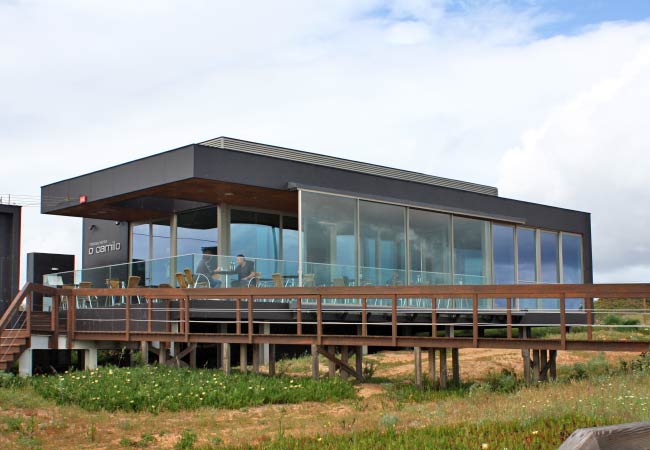
Boat Tours to Ponta da Piedade
One of the unique activities of Lagos is to explore the stunning Ponta da Piedade headland by boat. This fits perfectly with a day trip as tours are typically 75 minutes long and depart from the marina, which is close to the train station. By taking a small boat tour you gain the valuable insight of a local guide and also remove the need to walk the 1.5km from Lagos centre to the headland.
Tours cost around €17-€20 per person and run throughout the day, though booking ahead is recommended in summer when demand is highest. If you plan to do a kayak tour, it is advisable to go early in the morning when the sea tends to be at its calmest.
We have worked with GetYourGuide for the previous 7 years and some of their best boat tours include:
Self-Guided Walking Tour of Lagos
This walking tour covers all the main attractions of Lagos in a logical route that lets you experience the town's rich history and authentic Portuguese atmosphere.
The tour is divided into two parts: the green section shows the walking tour of the city (4km long), while the yellow section marks the coastal walk to Ponta da Piedade if you prefer to explore this stunning area on foot rather than taking a boat tour.
City tour: 1)Train station 2) Marina de Lagos 3) Ponte Pedonal 4) Avenida dos Descobrimentos 5) Mercado Municipal 6) Praça Gil Eanes 7) Museu Municipal 8) Mercado de Escravos 9) Museu Municipal 10) Igreja de Santa Maria 11) City walls 12)Arco de São Gonçalo 13) Forte da Ponta da Bandeira 14) Praia da Batata
Coastal tour: 15) Praia dos Estudantes 16) Praia do Pinhão 17) Praia Dona Ana 18) Praia do Camilo 19) Ponta da Piedade 20) Lighthouse 21) Praia do Canavial
Details of the walking tour of Lagos
The tour begins at Lagos Train Station (1), which is conveniently located next to the city's main free car park. Just a short walk away lies the Marina de Lagos (2), where an impressive collection of sailing yachts and tour boats moor in the calm waters. The marina is surrounded by pleasant cafés and restaurants, making it a perfect location for a stroll or food at the end of the tour.
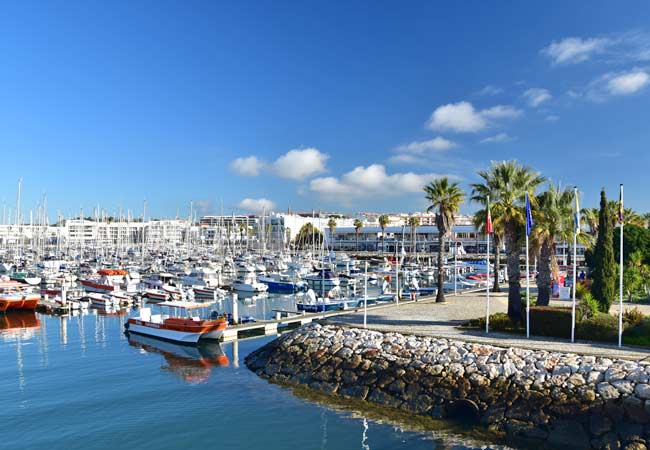
From the marina, the route crosses the Bensafrim River estuary by the pedestrian footbridge (3) and leads to the northern edge of Lagos' historic centre.

The Avenida dos Descobrimentos (4) follows the estuary southwards and there is a pretty riverside promenade, which you follow until the Mercado Municipal de Lagos.
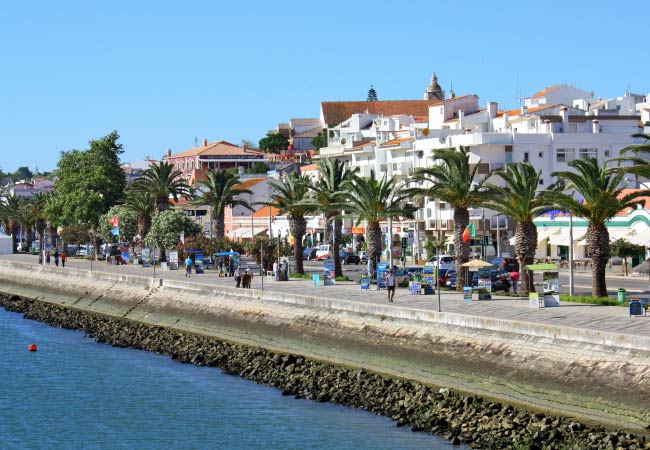
The promenade along the estuary and Avenida dos Descobrimentos
Inside this lively daily market, you will find a variety of stalls ranging from fresh fish, local produce including fruit veg, cakes and honey.
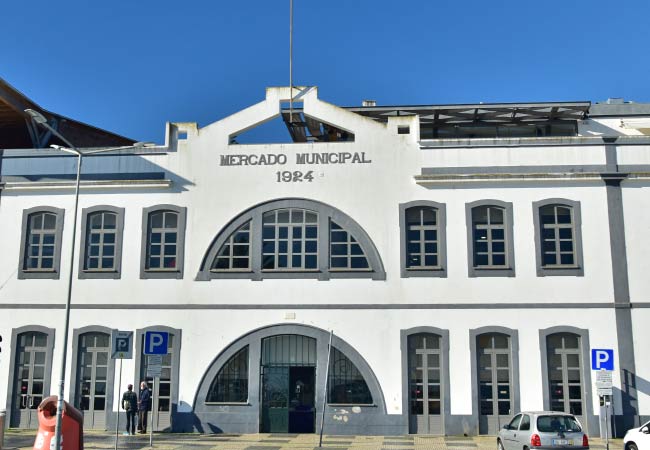
The tour now leaves the estuary and heads into the old quarter of Lagos, with its cobbled streets and traditional buildings. The Praça Gil Eanes is considered as the heart of the city. In the centre stands the striking modern statue of King Sebastião, which caused quite a stir among locals for its bold, abstract interpretation of the revered 16th-century monarch.
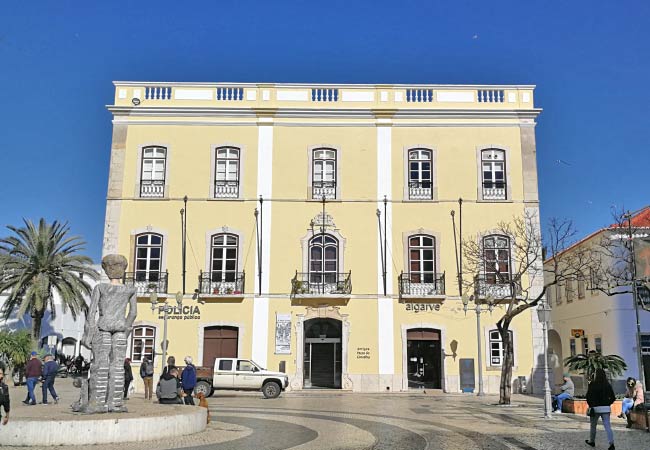
Around the square, you'll find cafés with outdoor seating, the cultural centre (Centro Cultural de Lagos), and the main tourist information office where you can pick up maps.
From Praça Gil Eanes, wander through the charming, narrow cobbled streets of the old town. Head generally south/southwest, where you'll discover a maze of pedestrianised lanes winding between whitewashed buildings adorned with decorative tilework.

Continue your exploration to Praça do Infante D. Henrique, where you'll find the Slave Market Museum (Mercado de Escravos). This simple white building with its distinctive arches housed enslaved Africans brought back by Portuguese explorers. Today it contains a small museum that documents this dark chapter in European history.

Close by is the Igreja de Santo António (Church of St. Anthony), which appears modest from the outside but contains one of the most spectacular church interiors in southern Portugal. Built in the 18th century, the church is famous for its stunning gilded woodwork covering almost every surface of the interior. The baroque golden carvings are especially impressive in the main altar.

Connected to the church is the Museu Municipal Dr. José Formosinho, a diverse collection covering archaeology, ethnography, religious art and local history. The museum houses everything from Roman artifacts to traditional Algarve costumes and artworks. While not large, it provides excellent context for understanding the region's rich history.
On the southern side of the Praça do Infante D. Henrique stands Igreja de Santa Maria, Lagos' main church. Originally built in the 15th century but reconstructed after the 1755 earthquake, this church features an ornate Baroque doorway and a peaceful interior that makes for a cool retreat on hot days.
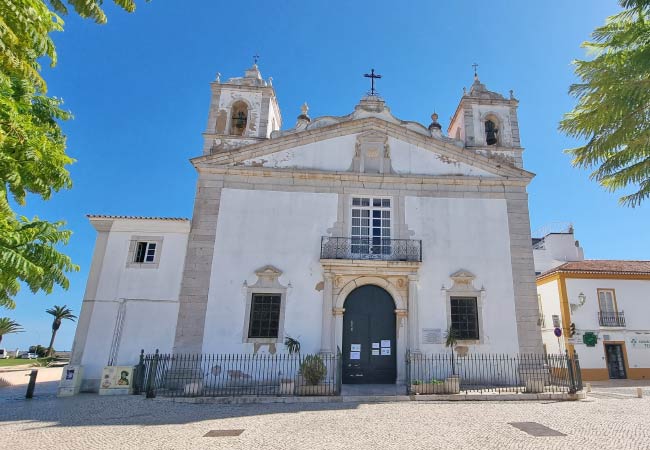
Follow the path along the well-preserved sections of the Lagos City Walls. These 16th-century fortifications protected the town from attacks, particularly from North African pirates.

Nearby, find the Arco de São Gonçalo, an ancient gateway in the city walls which shows the thickness of the defensive walls.
Head towards the waterfront from Praça do Infante D. Henrique to reach the Forte da Ponta da Bandeira, a small but well-preserved 17th-century fort that guarded the entrance to Lagos harbour. Built in 1690 during the Portuguese Restoration War, this square fortress with its drawbridge and chapel dedicated to St. Barbara (the patron saint of artillerymen) shows the town's strategic importance. The fort houses a small maritime museum and offers excellent views from its platform.
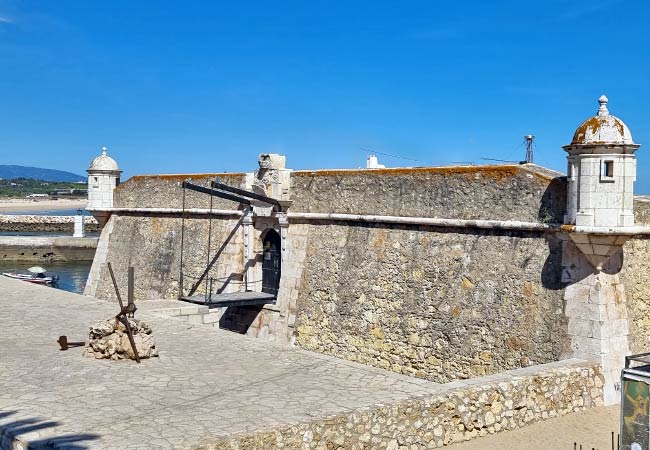
Behind the fort lies the charming Praia da Batata, Lagos' most accessible beach from the town centre. This sheltered cove offers protection from prevailing winds and currents, making it an ideal spot to relax on its soft golden sands.

This marks the point where the tour transitions into the coastal walk towards the Ponta da Piedade headland.
If you've planned to take a boat tour of Ponta da Piedade, this is an ideal moment to head back to the marina via Avenida dos Descobrimentos. Most boat tours depart from the marina area, and you'll find numerous tour operators with sales desks along the promenade on your way back.
Coastal tour walking tour
The coastal portion of the tour begins from the Praia da Batata.
Continue along the coastal path to Praia dos Estudantes. This beach is notable for its small bridge (Ponte do Antigo Forte do Pinhão) connecting the mainland to a rock outcrop—actually the remains of a private access built for a now-demolished 19th-century villa. Also within the headland is a tunnel to the smaller Praia da Caldeira, which is only accessible at low tide.
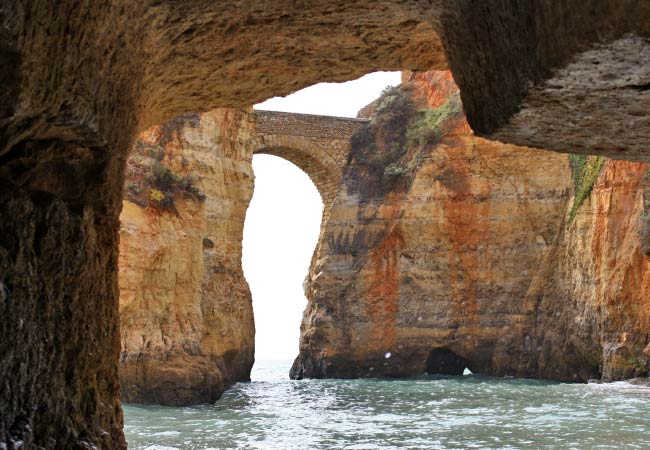
The coastal route now follows the cliff tops to the Praia Dona Ana beach. These cliffs have had significant erosion over the last few years, but the route passes the Praia do Pinhão and the steps leading down to it.
The Praia Dona Ana is widely regarded as one of Portugal's most beautiful beaches. The view from the clifftop is truly stunning - golden sands nestled between towering cliffs that contrast dramatically with the crystal-clear turquoise waters. Leading down to the beach are steps where the sheltered location creates calm swimming conditions. The beach is framed by impressive rock formations that have been sculpted by the sea over centuries.

Further along the is the Praia do Camilo, accessed by a wooden staircase of nearly 200 steps descending the cliff face. The effort is rewarded with a beautiful small beach divided by natural rock formations into intimate coves. At the top of the beach is the excellent Restaurante O Camilo, one of the best restaurants of the region.
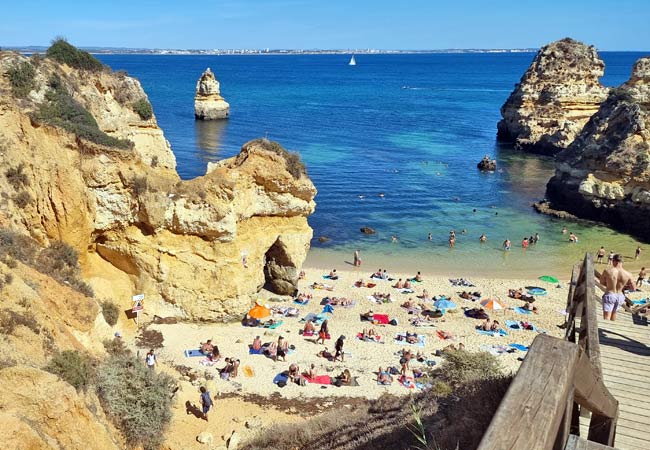
The walk culminates at Ponta da Piedade, featuring some of the most spectacular coastal scenery in Portugal. The golden limestone cliffs have been carved by the Atlantic into arches, grottos, and isolated rock stacks rising from the turquoise water.
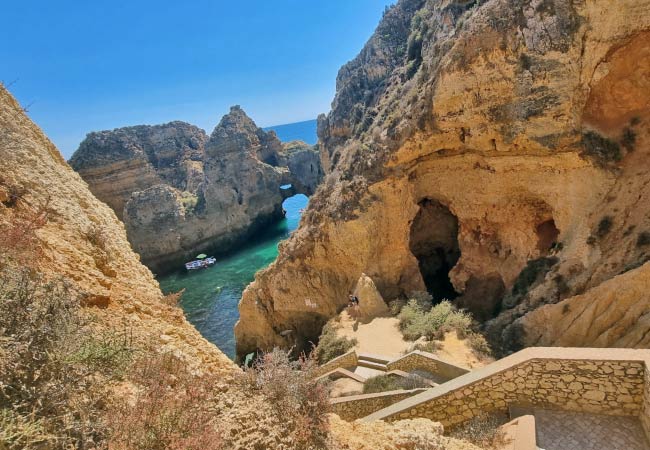
The steps down to the cove at the base of the cliffs
A lighthouse marks the promontory, and steep steps lead down to a small cove where fishermen launch boat tours of the caves.
After exploring the cove, follow the Ponta da Piedade headland to the Miradouro da Praia do Canavial viewpoint for a wonderful view westwards over the Praia do Canavial and as far as Praia da Luz on a clear day.

The view from the Miradouro da Praia do Canavial
From the viewpoint, walk back to the main road, where you could walk all the way back into the centre of Lagos or you could catch an Uber or Bolt.

















